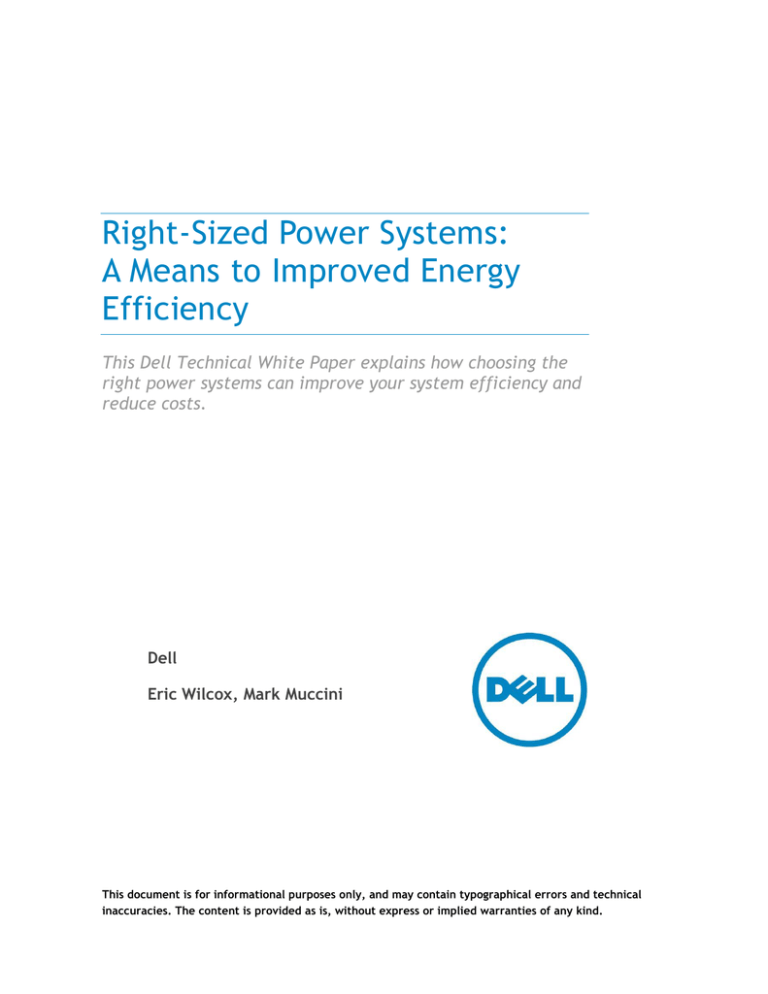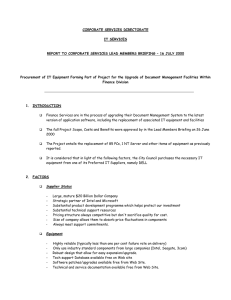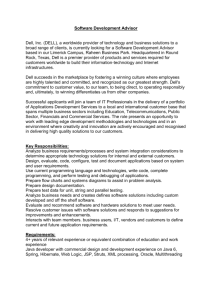
Right-Sized Power Systems:
A Means to Improved Energy
Efficiency
This Dell Technical White Paper explains how choosing the
right power systems can improve your system efficiency and
reduce costs.
Dell
Eric Wilcox, Mark Muccini
This document is for informational purposes only, and may contain typographical errors and technical
inaccuracies. The content is provided as is, without express or implied warranties of any kind.
Executive summary
As the cost of energy continues to rise, and the global focus turns to extracting as much
as possible from our energy resources, there is an increasing need to optimize IT
deployments for optimum efficiency. Companies are now focusing on using resources in
their IT environments to support business needs for longer durations. Other organizations
have outgrown their IT resources and are considering new data centers to align with their
growing business. Combine these business needs with growing environmental pressures
and social responsibilities, and energy efficiency has become a priority for many
companies.
Traditionally, energy efficiency is understood as the ratio of energy-in versus energy-out,
but we will explore a more in-depth look at that interaction within power supplies used
in enterprise-class servers. Any IT asset is an investment, and it may seem logical to
utilize that asset to its fullest potential. However, for power supplies and power
infrastructure products, there is an industry trend to over-size the asset compared with
the workload it will support. Dell hopes to establish a new trend and explain how to
right-size your power supply based on the configuration and workload of your IT
deployment, which can translate into energy savings and greater ROI.
Contents
Efficiency is a curve ............................................................................. 3
Savings potential ................................................................................. 5
The goal for asset utilization ................................................................... 6
Comparing efficiency improvement ........................................................... 6
Pursuit of the peak .............................................................................. 7
Power dissipation: a different way of quantifying the right approach ................... 8
Beyond the power supply ....................................................................... 9
Summary .......................................................................................... 9
ii
Efficiency is a curve
When choosing the right power supply for your system, a variety of factors that impact system
loading must be considered. Hardware configuration, operating temperature, system design, and
workloads vary how much power is required to support a server, both in deployment and operation.
Past generations of IT equipment have taken a worst-case approach when considering power
budgeting and system design. Although it has been rare to deploy equipment into the upper range of
operating temperatures, which drives higher system fan power usage, power budgeting has often
been poorly accounted for. Most hardware configurations rarely include high-power processors, the
highest-available memory allocations, maximum I/O population, and other options with the highest
available capacity or power consumption on a general purpose server. Additionally, there are very
few workloads or operating requirements that simultaneously tax each and every sub-system in the
hardware configuration. However, that is the exact scenario that many power supplies are designed
to support in traditional servers.
This design approach produces a power supply that is very capable and can support extreme
operating conditions, but the actual use case rarely exists. In general deployments, Dell is seeing
many instances of over-provisioning and operation that are not within the optimal range on the
energy efficiency curve. As we interact with our customers, we find that many of them are aware of
the peak efficiency of their system’s power supply. For the typical power supply efficiency curve
shown in
Figure 1, many customers are often aware of the peak value which surpasses 92% and approaches
93%. Looking at the same curve, we can see there would be great benefit in running the system
loading at or above 50%, the best efficiency for the power
sub-system.
Figure 1. Target range of operation
94%
92%
Efficiency
90%
88%
86%
84%
82%
80%
78%
0%
20%
40%
60%
80%
100%
Loading
3
When using
redundant power
supplies, the
ability to reach
peak efficiency
cannot be
attained. The
focus turns to
attaining loading
as close to the
50% point as
possible.
One solution to
the problem of
over-provisioning
is to select
lower-power
supplies, based
on configuration
and operating
conditions.
To enhance system up-time with redundant power supply deployments, which use
branch replication in power distribution, the highest attainable utilization is 50%. A
single power supply must be able to support system loading if the redundant power
supply or the utility feeding the branch fails or is taken offline. Most deployments are
focused on serviceability, reliability, and availability, which represents
approximately 80% deployment with redundant power supply units (PSUs). With that
in mind, the ability to reach the peak efficiency, which is at or above 50% loading,
cannot be attained. Therefore, the focus turns to attaining loading parameters as
close to the 50% point as possible. As the loading transitions towards lighter loads
(as shown on the left side of the curve in Figure 1), the efficiency of the system will
see continued degradation.
To better explain this concept, we will use an example with ideal conditions,
foregoing parameters such as load-sharing accuracy, regulation, power-factor
correction, and other minor contributors. This example (as shown in Figure 2) uses a
system that is designed with a power supply to support 1000W, with corner-case
parameters understood and budgeted for concerning hardware configuration,
operating conditions, and workload. However, using a typical configuration, this
system has a mid-level processor, about 50% of memory capacity and frequency, and
populates only one or two I/O slots in the system. Under the actual workload, the
system is found to draw 400W under the most extreme usage model. When operating
with redundant power supplies, the power capability is 2000W, but only a maximum
of 400W is required. The 400W represents the maximum draw, with many instances
of IT workloads representing less than 400W, as workloads are dynamic. In this case,
the system is utilizing only 20% of its capacity. Instead of operating above 92%
efficiency, it operates at or below 88% efficiency.
The main limitation for power efficiency was caused by using 1000W PSUs. One
solution to this problem can be to select lower-power variants based on configuration
and operating conditions. In this example, if two 500W PSUs were used in redundant
operation, the operating position on the efficiency curve would be at 40% load and
approximately 92% efficiency. This is a good example of right-sizing a power supply
for the actual system load.
4
Figure 2. Operating near the peak of the curve
94%
92%
Efficiency
90%
88%
Redundant power
supplies:
86%
2 x 500W
84%
2 x 1000W
82%
80%
78%
0%
20%
40%
60%
80%
100%
Loading
Savings potential
Right-sizing your
power supplies
can translate to
more return and
less investment in
your ROI equation.
To translate this into more meaningful parameters, this example of right-sizing would
result in an efficiency improvement of 4%, or 16W per server. Industry experts
suggest that for each watt saved per server, per year, a savings of $2.12 can be saved
annually.1 In our example, the savings would represent approximately $34 per server,
per year.
If you consider the utility costs, operating expenditures, and capital expenditures
associated with distributing and provisioning power throughout your data center,
these savings can be very attractive. To add to these savings, lower-power devices
are available at lower cost, which can translate into more return and less investment
in your ROI equation. This allows for simple reductions on both sides—a win-win
proposal.
1
Annual Fully Burdened Cost of Power; James Hamilton; 2008:
http://perspectives.mvdirona.com/2008/12/06/AnnualFullyBurdenedCostOfPower.aspx
5
The goal for asset utilization
The old adage,
more is better,
does not
necessarily apply
for power-supply
sizing.
In the previous example, there is still an underlying need for the power supply to be
able to support corner-case configurations and operating modes. With the availability
of right-sized power supplies, a new barrier has emerged that needs to be addressed.
The old adage, more is better, does not necessarily apply for power-supply sizing.
Many IT professionals are making assumptions and over-provisioning the power
systems to ensure there is sufficient headroom and to avoid downtime conditions.
With the advent of power management features in today’s systems, which enable
real-time assessment of power requirements and comparison against power supply
capacity through an intelligent interface, the exposure to downtime is negligible.
Today’s servers are capable of understanding worst-case predictions based on
configuration, following up with real-time consumption measurements, and managing
resources and uptime accordingly.
System throttling (through various means) can reduce the overall consumption,
maintaining system operation using the available resources from the power
sub-system. Within Dell’s server design parameters, this is addressed as an excursion
event, not as typical operation. This is an important point, as there is a common
misconception that running a system at or near its potential will automatically result
in reduced performance. In fact, Dell systems are only designed to throttle as a
fail-safe, which rarely occurs in normal operating conditions.
The power supply is an asset within the data center and has been designed to
operate at its maximum rated power with high reliability and availability. There is no
need to de-rate the power supply or over-provision, as there are no tangible
benefits—there are only additional costs of operation and procurement. The goal for
power supply asset-utilization should be targeted at maximum power capability.
Another reason for over-provisioning is to accommodate potential future needs, such
as provisioning additional memory, hard drives, I/O, or other system resources. A
simple answer to this dilemma is to expand the power-supply capability at the point
when additional resources are procured. Dell has provided a common form factor and
system interface to make the power supplies easily interchangeable and
upgradeable. The savings realized from right-sized deployments can help offset the
upgrade costs when aligning to new system hardware. If you follow a planned
cadence of upgrades that makes sense from an initial investment standpoint,
choosing a properly-sized power supply for the majority of your system’s operating
life is the best approach.
Comparing efficiency improvement
Many regulatory and compliance agencies have focused on improving efficiency
curves over the past several years with great improvement in the overall reduction of
energy consumption. This next comparison intends not to slight those efforts, but to
6
highlight the comparative benefits of a right-sized approach. Consider our earlier
power supply efficiency curve with the additional curve shown in Figure 3.
Figure 3. Silver and Gold PSU efficiency
94%
92%
Efficiency
90%
88%
86%
84%
82%
80%
78%
76%
0%
20%
40%
60%
80%
100%
Loading
Not only do
intelligent sizing
and provisioning
for your system
needs provide
more of a
measurable
benefit, they do
so at reduced
cost.
Efficiency curves, such as these, have been continually improved in the IT industry
through much design effort, additional expense to attain performance, and
engineering excellence. Between the two curves shown in Figure 3, which represent
EPA 80-Plus Gold- and Silver-compliant power supplies, there is a difference of 2%
(at most) to 0.5% or less in various locations. To attain the upper-efficiency curve
represented by Gold compliance, an additional investment is required, but the
maximum potential benefit is only a 2% improvement. Compare this result with the
previous right-sizing example, which represented a minimum of 4% improvement and
reduced the procurement burden. Not only do intelligent sizing and provisioning for
system needs provide more of a measurable benefit, but they do so at reduced cost
when compared to standard engineering efficiency improvements.
Pursuit of the peak
As discussed earlier, efficiency is a curve, and our goal is to make sure you are able
to operate your systems at peak efficiency. For systems operating in non-redundant
mode, taking advantage of peak operation is a bit more attainable. For systems
operating in redundant operation, the importance of right-sizing is more critical, as
the highest-attainable utilization under normal conditions is 50%.
To compliment your right-sizing approach, Dell offers features within the powermanagement system, such as hot standby, which allows the product to operate at
higher efficiency for light loads. By putting the redundant power supply in a ready
position, the power supply that supports the load climbs the curve for loading and
7
efficiency towards a peak operating efficiency. Also, Extended Power Range operation, which is built
in to Dell systems, moves the operating load up the efficiency curve and utilizes system management
to respond to a power-supply module failure through system management resources. One of Dell’s
main goals is to continually find ways to optimize operating efficiencies and ensure product
operation in real-world environments at their peak.
Power dissipation: a different way of quantifying the
right approach
So far, the examples and information we have provided have been discussed in terms of efficiency. In
order to quantify how many watts will be saved in these examples, power dissipation should be
understood. For the following 502W and 717W PSU examples, the associated power dissipation (Pdis)
curves are respectively shown in Figure 4 and Figure 5.
Figure 4. Single 717W Silver PSU: Pdis vs. load
90
Power dissipation (W)
80
70
60
50
Pdis
40
30
Poly.
(Pdis)
20
10
0
0
200
400
600
800
Load (W)
Power dissipation (W)
Figure 5. Single 502W Gold PSU: Pdis vs. load
50
45
40
35
30
25
20
15
10
5
0
Pdis
Poly.
(Pdis)
0
100
200
300
400
500
600
Load (W)
8
Returning to our example of a 400W system load, assuming redundant operation,
each PSU would be operating at approximately 200W of load. From the power
dissipation curves shown in Figure 4 and Figure 5, you can see how this translates to
~18W of dissipation for a 502W PSU while the same system load supported with a
717W translates to ~27W of dissipation. The net of the improved efficiency and
right-sized approach is 9W of power dissipation savings per PSU, or 18W per system.
Beyond the power supply
While the efficiency curves represented in this document are not an exact
representation of all power conversion devices, many UPSs, VRs, and other power
conversion devices have similar characteristics and operating behaviors. With the
expansion of intelligent power and infrastructure devices and their ability to interact
with system power-management controls, the principles of right-sizing apply beyond
the power supply. As an IT professional who is interested in improving the overall
efficiency of an IT solution, a more rigorous investigation of actual operating
behaviors for products can provide some much-needed insight. Once the operating
behaviors are understood, a focus on asset utilization to its rated capacity and rightsizing for operational and cost efficiencies can yield significant benefit.
Summary
Dell continues
to invest in the
right-sizing
strategy through
our entire
portfolio
approach.
Right-sizing is an action that you can take today in your data center or compute
solution. Right-sizing offers the following benefits:
Full-asset utilization
Optimal efficiency and performance
Reduced procurement expense
Reduced power-supply and server-operating expense
Reduction in overall infrastructure and facility provisioning
Flexibility to grow as you go with alternate power levels in the same form factor
No additional exposure to downtime or performance degradation
Intelligent provisioning and utilization of industry-leading technology that
empowers you to do more within your IT environment
If you are looking for non-redundant or redundant options, Dell offers right-sized
products in our mainstream, performance, and value products that can help you to
extract the efficiency benefits outlined in this document. Dell continues to invest in
the right-sizing strategy and will continue to expand our right-sized offerings with
multiple variants of power supplies for each model, as well as an entire portfolio
approach to anticipate the varying needs of our customers.
9
Learn more
Visit Dell.com/PowerEdge for more information on Dell™ PowerEdge™ servers.
About the authors
Eric Wilcox: Marketing Power and Cooling Portfolio Manager at Dell
Mark Muccini: Advanced Engineering Sr. Consultant at Dell.
© 2011 Dell Inc. All rights reserved. Dell and its affiliates cannot be responsible for errors or omissions in typography or
photography. Dell, the Dell logo, and PowerEdge are trademarks of Dell Inc. Other trademarks and trade names may be used in
this document to refer to either the entities claiming the marks and names or their products. Dell disclaims proprietary interest
in the marks and names of others.
October 2011 | Rev 1.0
10






